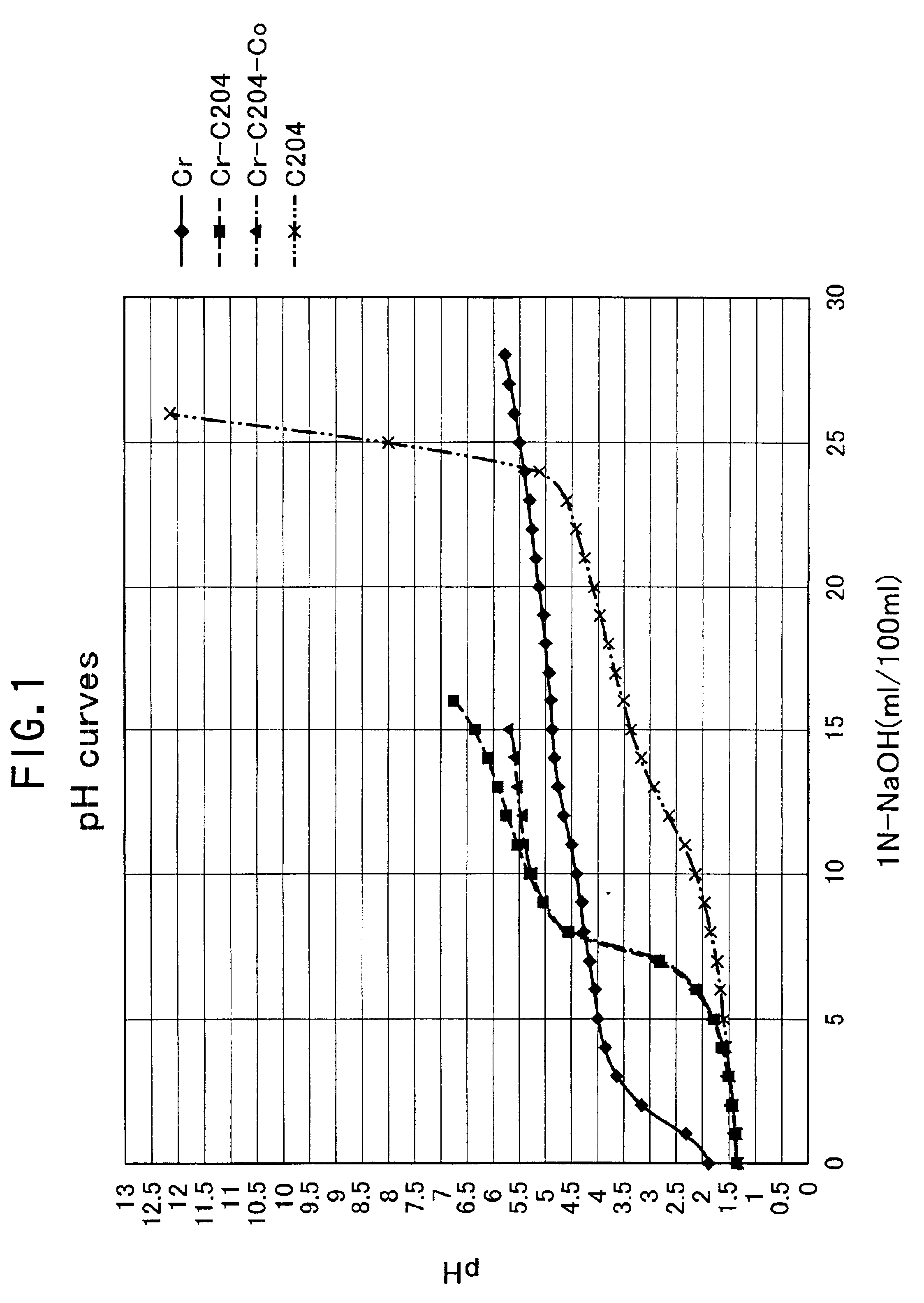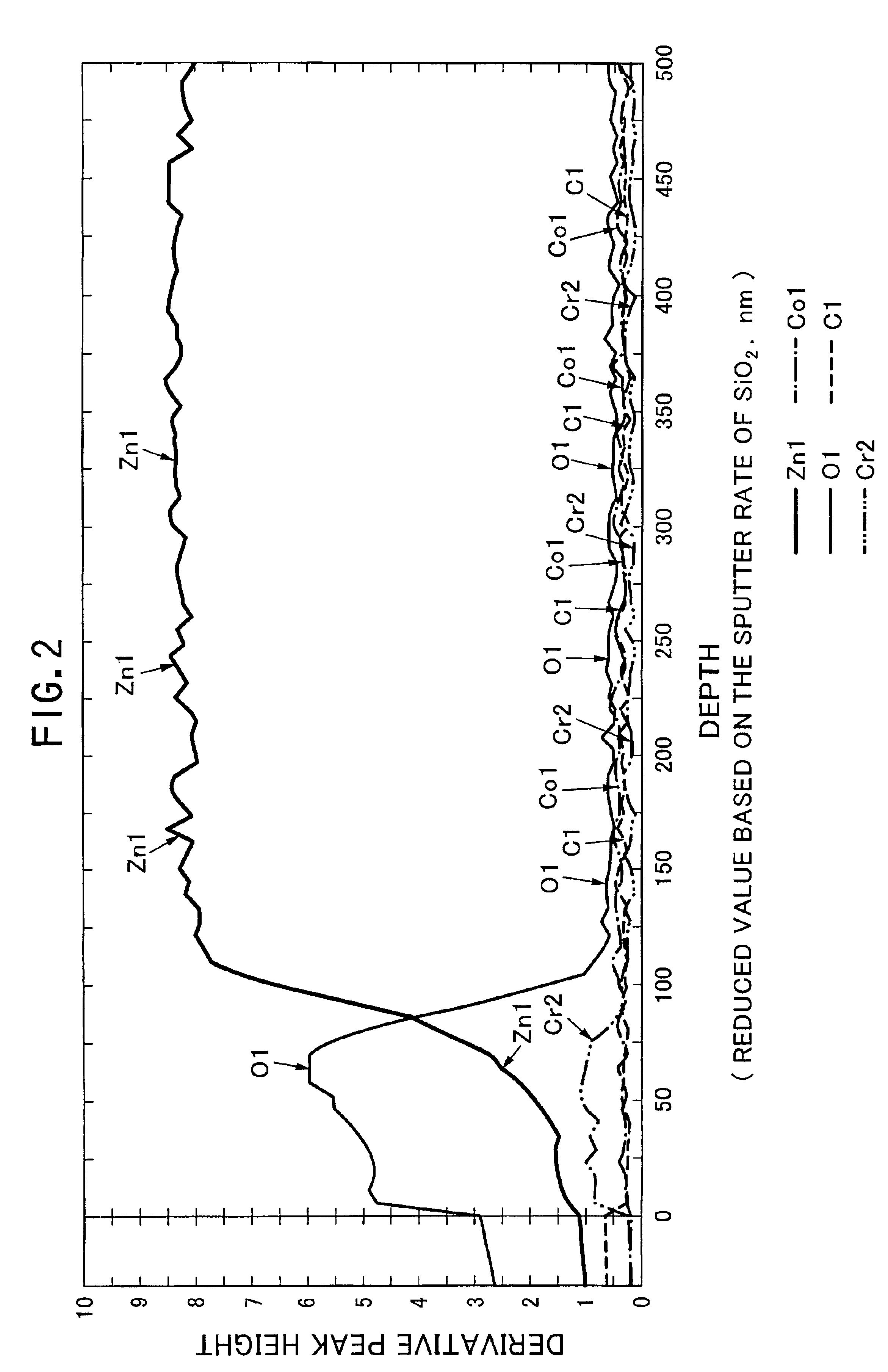Processing solution for forming hexavalent chromium free and corrosion resistant conversion film on zinc or zinc alloy plating layers, hexavalent chromium free and corrosion resistant conversion film, method for forming the same
a technology of hexavalent chromium free and corrosion resistance, applied in the direction of solid-state diffusion coating, transportation and packaging, coatings, etc., can solve the problems of inability to ensure sufficient corrosion resistance of metal, inability to ensure the stable corrosion resistance of the resulting film, and inability to ensure the effect of corrosion resistance stability
- Summary
- Abstract
- Description
- Claims
- Application Information
AI Technical Summary
Benefits of technology
Problems solved by technology
Method used
Image
Examples
examples 1 to 5
A steel plate, which had been plated with Zn in a thickness of 8 μm, was immersed in a trivalent chromate-containing processing solution having a composition as shown in the following Table 2 and then washed with water.
TABLE 2Ex. No.12345Cr3+ (g / L)13355NO3− (g / L)515182530PO4− (g / L)00.3001Oxalic acid (g / L)3881212Co2+ (g / L)11112pH of Processing2.02.02.01.82.2Soln.Processing Temp. (° C.)3030303030Processing time (sec.)6040404040
In Table 2, Cr3+ sources used were CrCl3 (in Examples 3 and 5) and Cr(NO3)3 (in Examples 1, 2 and 4); the oxalic acid used was dihydrate; and Co2+ source used was Co(NO3)2. Further NO3− sources used were HNO3 (in Examples 1, 2 and 4) and NaNO3 (in Examples 3 and 5). The balance of each processing solution was water. Moreover, the pH value of each solution was adjusted using NaOH.
examples 6 to 10
A steel plate, which had been plated with Zn in a thickness of 8 μm, was immersed in a trivalent chromate-containing processing solution having a composition as shown in the following Table 3. The steel plate was once dried after the treatment and the steel plate was further heated at 200° C. for 2 hours to thus examine the corrosion resistance after heating.
TABLE 3Ex. No.678910Cr3+ (g / L)44444NO3− (g / L)2020202020Oxalic acid (g / L)1212121212Co2+ (g / L)0.51248pH of Processing2.22.22.22.22.2Soln.Processing Temp.3030303030(° C.)Processing time4040404040(sec.)
In Table 3, the Cr3+ source used was Cr(NO3)3; the oxalic acid used was dihydrate; and the Co2+ source used was Co(NO3)2. Further the NO3− source used was NaNO3. The balance of each processing solution was water. Moreover, the pH value of each solution was adjusted using NaOH.
examples 11 to 13
After the trivalent chromate treatment in Example 3, the steel plate was subjected to a topcoating treatment. The conditions for the topcoating treatment used herein are summarized in the following Table 4.
TABLE 4Ex. No.111213Kind ofSilicate typePolyurethane typeMethacrylic resinTopcoatinorganic filmorganic filmtype organic filmConcn. Of200 mL / L100 mL / LStock solutionProcessingwas used as suchSoln.Processing45° C. - 45 sec25° C. - 60 sec25° C. - 60 secConditionsName andCC-445SUPERFLEX R3000DIPCOAT WOrigin ofavailable fromavailable from Daiichiavailable fromReagentDipsolKogyo SeiyakuDipsol ChemicalsChemicals Co.,Co., Ltd.Co., Ltd.Ltd.
PUM
| Property | Measurement | Unit |
|---|---|---|
| Temperature | aaaaa | aaaaa |
| Temperature | aaaaa | aaaaa |
| Time | aaaaa | aaaaa |
Abstract
Description
Claims
Application Information
 Login to View More
Login to View More - R&D
- Intellectual Property
- Life Sciences
- Materials
- Tech Scout
- Unparalleled Data Quality
- Higher Quality Content
- 60% Fewer Hallucinations
Browse by: Latest US Patents, China's latest patents, Technical Efficacy Thesaurus, Application Domain, Technology Topic, Popular Technical Reports.
© 2025 PatSnap. All rights reserved.Legal|Privacy policy|Modern Slavery Act Transparency Statement|Sitemap|About US| Contact US: help@patsnap.com


